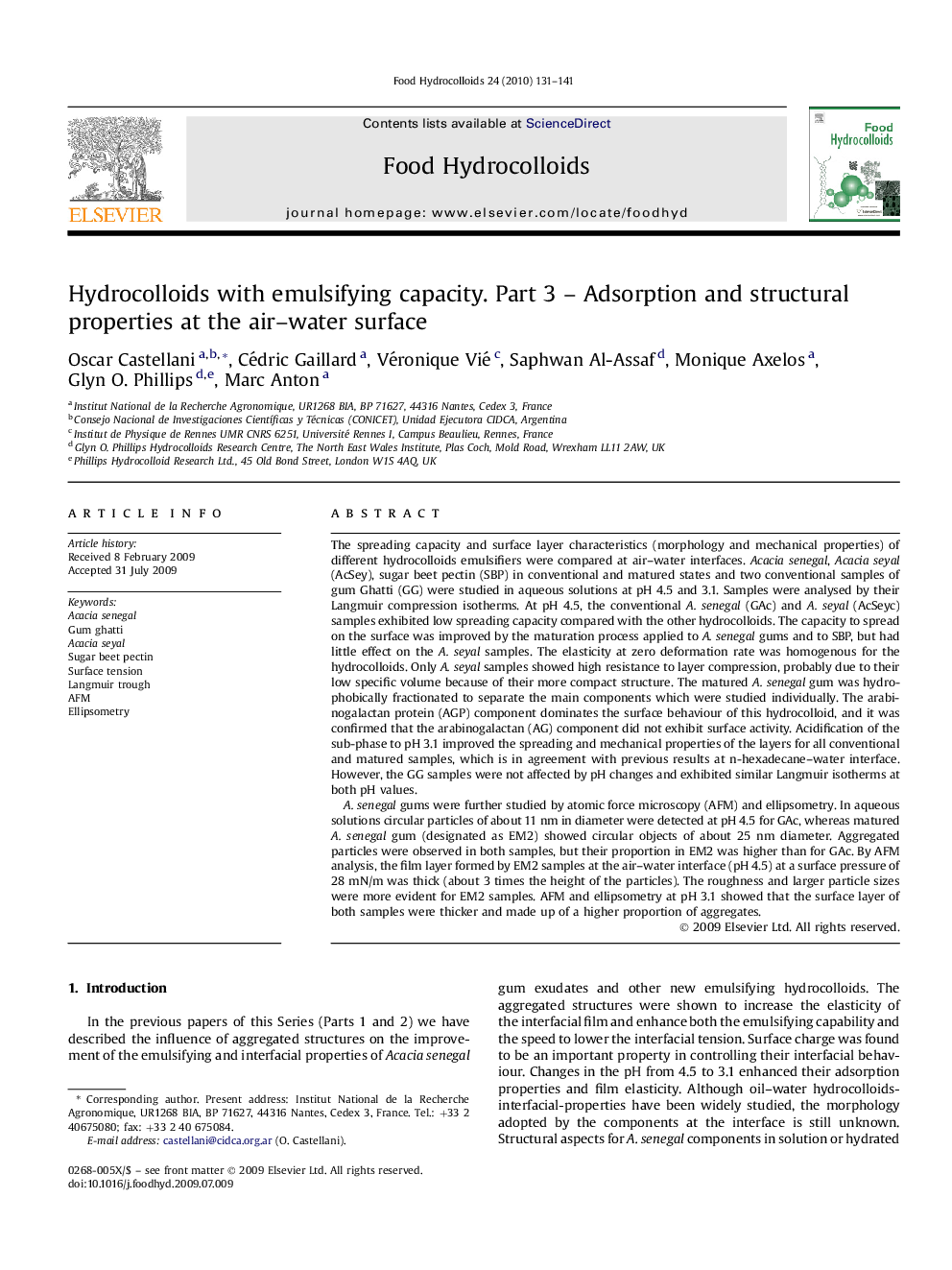| کد مقاله | کد نشریه | سال انتشار | مقاله انگلیسی | نسخه تمام متن |
|---|---|---|---|---|
| 605016 | 1454444 | 2010 | 11 صفحه PDF | دانلود رایگان |

The spreading capacity and surface layer characteristics (morphology and mechanical properties) of different hydrocolloids emulsifiers were compared at air–water interfaces. Acacia senegal, Acacia seyal (AcSey), sugar beet pectin (SBP) in conventional and matured states and two conventional samples of gum Ghatti (GG) were studied in aqueous solutions at pH 4.5 and 3.1. Samples were analysed by their Langmuir compression isotherms. At pH 4.5, the conventional A. senegal (GAc) and A. seyal (AcSeyc) samples exhibited low spreading capacity compared with the other hydrocolloids. The capacity to spread on the surface was improved by the maturation process applied to A. senegal gums and to SBP, but had little effect on the A. seyal samples. The elasticity at zero deformation rate was homogenous for the hydrocolloids. Only A. seyal samples showed high resistance to layer compression, probably due to their low specific volume because of their more compact structure. The matured A. senegal gum was hydrophobically fractionated to separate the main components which were studied individually. The arabinogalactan protein (AGP) component dominates the surface behaviour of this hydrocolloid, and it was confirmed that the arabinogalactan (AG) component did not exhibit surface activity. Acidification of the sub-phase to pH 3.1 improved the spreading and mechanical properties of the layers for all conventional and matured samples, which is in agreement with previous results at n-hexadecane–water interface. However, the GG samples were not affected by pH changes and exhibited similar Langmuir isotherms at both pH values.A. senegal gums were further studied by atomic force microscopy (AFM) and ellipsometry. In aqueous solutions circular particles of about 11 nm in diameter were detected at pH 4.5 for GAc, whereas matured A. senegal gum (designated as EM2) showed circular objects of about 25 nm diameter. Aggregated particles were observed in both samples, but their proportion in EM2 was higher than for GAc. By AFM analysis, the film layer formed by EM2 samples at the air–water interface (pH 4.5) at a surface pressure of 28 mN/m was thick (about 3 times the height of the particles). The roughness and larger particle sizes were more evident for EM2 samples. AFM and ellipsometry at pH 3.1 showed that the surface layer of both samples were thicker and made up of a higher proportion of aggregates.
The air–water spreading capacity and surface layer characteristics (morphology and mechanical properties) of conventional and matured hydrocolloids emulsifiers (Acacia senegal, Acacia seyal and Sugar Beet Pectin) were compared at pH 4.5 using the Langmuir trough. Maturation process improved the spreading capacity of A. senegal and Sugar Beet Pectin. Coventional Ghatti gum behaved similar to these matured hydrocolloids. AGP component from matured A. senegal dominates its surface behaviour. At pH 3.1 the surface properties of almost all hydrocolloids were improved. AFM and ellipsometry analysis of interfacial films from A. senegal revealed different surface morphology between the non-matured and matured gums and the ability, of both samples, to form a thicker film at pH 3.1.
Journal: Food Hydrocolloids - Volume 24, Issues 2–3, March–May 2010, Pages 131–141